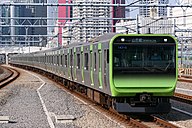
Back Пасажырскі цягнік Byelorussian Пасажырскі цягнік BE-X-OLD Vlak pro přepravu cestujících Czech Reisezug German Reisirong Estonian قطار مسافربری Persian Matkustajajuna Finnish Train de voyageurs French Putnički vlak Croatian Kereta api penumpang ID
| Part of a series on |
| Rail transport |
|---|
 |
|
|
| Infrastructure |
|
|
| Service and rolling stock |
|
| Special systems |
|
|
| Miscellanea |
|
|
A passenger train is a train used to transport people along a railroad line.[1][2] These trains may consist of unpowered passenger railroad cars (also known as coaches or carriages) hauled by one or more locomotives, or may be self-propelled; self propelled passenger trains are known as multiple units or railcars. Passenger trains stop at stations or depots, where passengers may board and disembark. In most cases, passenger trains operate on a fixed schedule and have priority over freight trains.
Passenger trains may be made up of a number of passenger cars hauled by one or more locomotives, or may be made up of self-propelled railcars. Car design and the general safety of passenger trains have dramatically evolved over time, making travel by rail remarkably safe. Some passenger trains, both long-distance and short-distance, use bi-level (double-decker) cars to carry more passengers per train. Passenger trains hauled by locomotives are more expensive to operate than multiple units, but have a higher passenger capacity.[3]
Many prestigious passenger train services have been bestowed a special name, some of which have become famous in literature and fiction.[citation needed]
- ^ "Passenger train definition and meaning". Collins English Dictionary. Retrieved 1 February 2022.
- ^ "Definition of PASSENGER TRAIN". www.merriam-webster.com. Retrieved 1 February 2022.
- ^ Connecticut Department of Transportation (June 2005). "Final Report: New Haven Hartford Springfield Commuter Rail Implementation Study" (PDF). CT.gov. Retrieved 9 November 2021.



